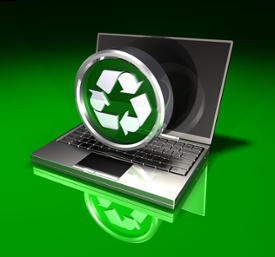 From the perspective of environmental compliance, recycling your organization’s retired IT equipment can be a constant source of concern. The cost to your company — and your own professional reputation — of violating environmental regulations can be significant. Many organizations choose to partner with an IT asset disposition (ITAD) provider, but after you give your equipment over to a vendor, do you know what that vendor does with it? Keep in mind that, even if you have turned over equipment to a vendor, if the equipment has been disposed of improperly and it can be traced back to your organization (often it can), your organization could be liable. You will want to make sure any “certificate” of recycling you receive is backed by more than just the paper it’s printed on.
From the perspective of environmental compliance, recycling your organization’s retired IT equipment can be a constant source of concern. The cost to your company — and your own professional reputation — of violating environmental regulations can be significant. Many organizations choose to partner with an IT asset disposition (ITAD) provider, but after you give your equipment over to a vendor, do you know what that vendor does with it? Keep in mind that, even if you have turned over equipment to a vendor, if the equipment has been disposed of improperly and it can be traced back to your organization (often it can), your organization could be liable. You will want to make sure any “certificate” of recycling you receive is backed by more than just the paper it’s printed on.
How can you be sure your IT asset disposition partner follows the latest and best recycling practices and is fully compliant with all state and federal environmental regulations? Choose a certified vendor.
R2/RIOS certification
R2/RIOS is a combined certification and an industry benchmark for proper electronics recycling and reuse. This dual standard combines the broader Recycling Industry Operating Standard (RIOS) with the electronics recycling industry-specific Responsible Recycling (R2) Practices. Think of it like a cake. The base layer is RIOS, developed by the Institute of Scrap Recycling Industries (ISRI) for the broader recycling industry. It’s an ANSI accredited standard that includes all of the attributes and processes from ISO:9001 (Quality), ISO:14001(Environmental), and OHSAS:18001(Safety). R2 is best practices specifically for the electronics industry and electronic waste.
R2/RIOS certification tells you that your electronics asset disposition partner has an audited management system in place. This provides the framework for processes, procedures, and improvements. For the enterprise or organization with IT assets to retire, R2/RIOS assures you of a consistent level of service across time and locations. It also assures you that your ITAD partner is qualified to handle recycling your equipment according to all state and federal environmental regulations.
Data erasure
One of the biggest challenges for everyone participating in the IT asset disposition process is data security. There are environmental concerns involved in data erasure, as well. When a drive can’t be wiped (it won’t boot, it’s got damage and the software can’t complete the erasure) what does your vendor do with that drive? It needs to be destroyed and disposed of properly, again in full compliance with state and federal regulations. If you are selling IT assets to a broker or remarketer, make sure you know how they perform data erasure and what they do with any assets or hard drive that can’t be sold. You are still liable for the data and the environmental compliance.
Lifespan offers a free resource, “10 Myths About IT Asset Disposition (ITAD) Data Erasure,” which addresses many of the misconceptions that exist about the process, standards, and technology related to data erasure and sanitization. It sheds some light on the data erasure process, dispelling some of the most common myths and discussing the best practices for optimizing your organization’s ITAD program in this area.


